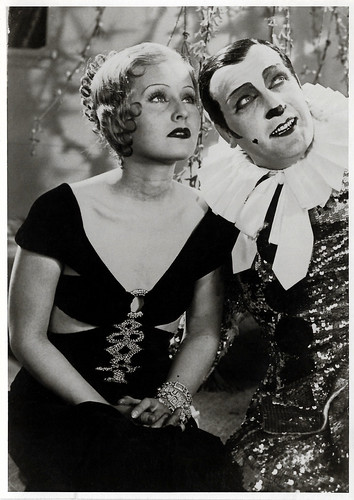
German postcard by Agfa. Photo: Ufa. Hans Albers and Lilian Harvey in Quick (Robert Siodmak, 1932).
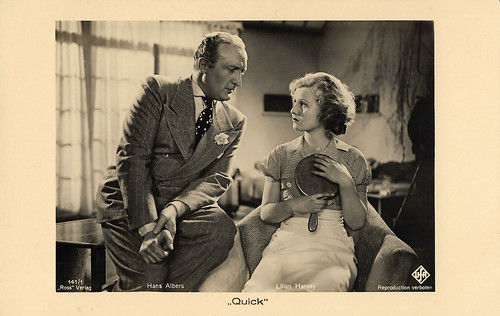
German postcard by Ross Verlag, no. 141/1. Photo: Ufa. Hans Albers and Lilian Harvey in Quick (Robert Siodmak, 1932).

German postcard by Ross Verlag, no. 141/2. Photo: Ufa. Hans Albers and Lilian Harvey in Quick (Robert Siodmak, 1932).

German postcard by Ross Verlag, no. 141/3. Photo: Ufa. Hans Albers and Paul Hörbiger in Quick (Robert Siodmak, 1932).
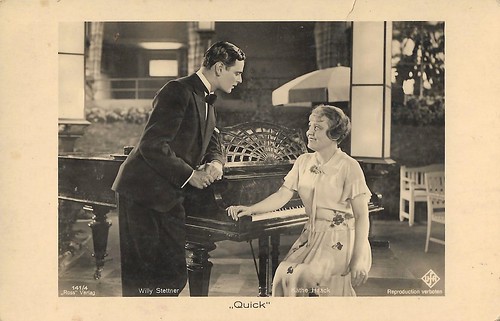
German postcard by Ross Verlag, no. 141/4. Photo: Ufa. Käthe Haack and Willy Stettner in Quick (Robert Siodmak, 1932).
Witty dialogues and charming stars
Lilian Harvey plays 21-year-old divorcee Eva Prätorius who is taking some time in a posh spa, the Sonneneck sanatorium, which is under the medical management of the respected Prof. Bertram. Every evening she keeps sneaking out to the Apollo Theatre, the town's vaudeville theatre. She wants to see a performer, the musical clown Quick (Hans Albers in heavy white make-up), do his act.
Eva goes backstage to meet Quick. But she doesn't recognise him when he happens to stand in front of her - without make-up, as she has never seen him before. He also begins to take a shine for the young, capricious woman who adores him every evening from her box. He tries to woo her, masquerading as the theatre's manager.
Quick tries to get her to fall in love with who he is in real life but Eva only likes him as a person who can introduce her to Quick. Unable to resolve her feelings for both the clown and the theatre manager, Eva is angered when she finally learns that they are one and the same. But not for long, of course...
Quick (Robert Siodmak, 1932) was clearly based on a stage play, by Félix Gandéra, and was not a particularly good showcase for any of the main talents except for Hans Albers. However, the mistaken identity and following runaround are never tiresome as and Quick is better than most Ufa films in this genre.
Mayesgwtw39 (IMDb) notes that Quick contains "some witty dialogue [by Hans Müller], but the stars are relying mostly on their screen personas to supply the charm. They do so quite effectively from the leads to the supporting cast. The whole thing makes for a lively and somewhat stylish farce." The sets were designed by art director Erich Kettelhut. Max Pfeiffer was the production manager and film editor Viktor Gertler also served as Robert Siodmak's assistant director.

German postcard by Ross Verlag, no. 141/5, 1931-1932. Photo: Ufa. Hans Albers, Paul Hörbiger, Paul Westermeier and Genia Nikolaieva in Quick (Robert Siodmak, 1931).

German postcard by Ross Verlag, no. 141/6. Photo: Ufa. Lilian Harvey and Hans Albers in Quick (Robert Siodmak, 1932). Collection: Geoffrey Donaldson Institute.
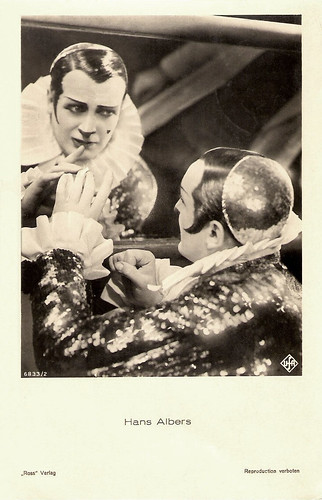
German postcard by Ross Verlag, no. 6833/2, 1931-1932. Photo: Ufa. Hans Albers in Quick (Robert Siodmak, 1932).
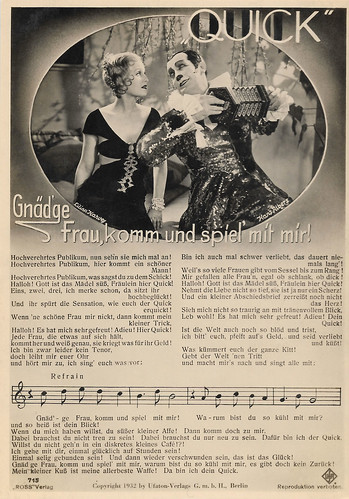
German postcard by Ross Verlag, no. 715/1. Photo: Ufa. Hans Albers and Lilian Harvey in Quick (Robert Siodmak, 1932). Songtext of 'Gnädige Frau, komm und spiel mit mir' (Madam, come and play with me). Copyright: Ufaton-Verlag, 1932.
Sources: Mayesgwtw39 (IMDb), Wikipedia (German and English), and IMDb.
This post was last updated on 19 March 2023.
No comments:
Post a Comment